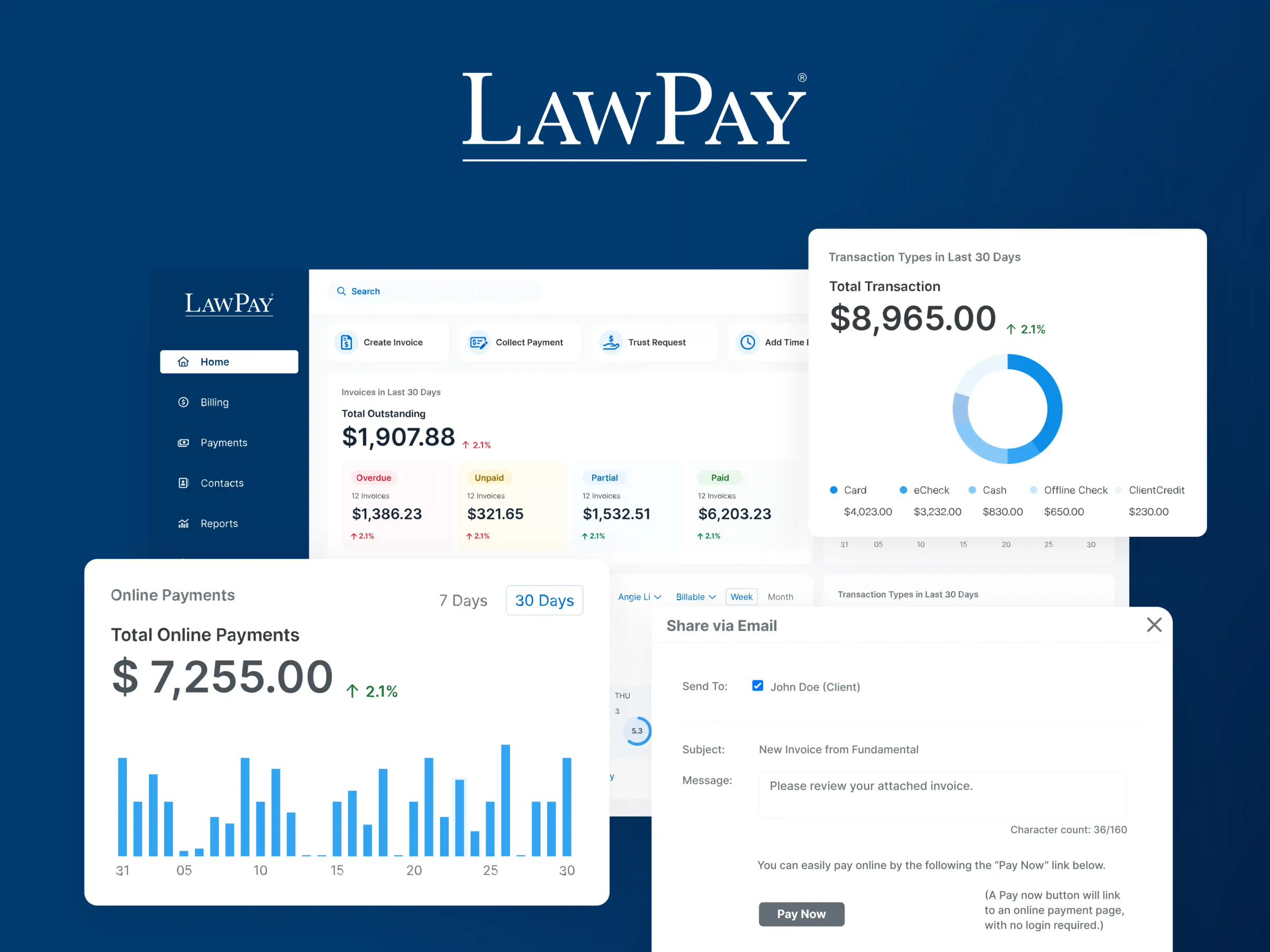Handling a legal matter is a complex and involved undertaking, and one of the chief concerns people have about the process is high legal fees. At an average hourly rate of $250-$350, hiring a lawyer can be an expensive proposition—and it may be intimidating enough to cost you valuable potential clients.
One solution you may want to consider is offering a range of legal fee agreements. This will let your clients rest easy knowing that they can choose a fee structure that makes sense for their circumstances.
But each type of attorney-client agreement involves different tradeoffs with respect to payment collection, cash flow, and other aspects of managing a legal practice. In this article, we’ll go over different types of attorney fees and their respective pros and cons to help you make the best decision.
Schedule a demo to see what LawPay can offer your firm.
Book Now
What is an Attorney Fee Agreement?
A lawyer fee agreement solidifies how legal services are paid. It’s important to consider all the options available, just as you do when thinking about which office you want to lease or which invoicing software you want to use.
What Are The Most Common Types of Legal Fee Agreements for Clients?
The most common types of attorney fees are flat fees, hourly payments, contingency fees, and evergreen retainers. Below, we’ll walk through each of these options.
Flat Fees
With a flat fee agreement, you’ll take on a case for a set rate that’s agreed upon upfront.
Deciding whether a flat fee makes sense for you will depend upon your financial situation, your client base, and the kinds of cases you handle.
For cases that tend to be relatively consistent, like DUI or basic traffic incidents, a flat fee might make more sense than an hourly rate. Of course, if one of these cases are open longer than anticipated, you might end up losing money on it.
Hourly Rates
An hourly rate agreement involves a legal professional directly selling their hours to clients, rather than working from a retainer or a flat fee.
The obvious advantage of an hourly rate is its flexibility–if a case finishes quickly you can make your client happy with a bill that’s smaller than anticipated and move on to the next project. If it takes longer than expected, you are fairly compensated for your time.
The clear disadvantage, however, is that high hourly rates can scare off potential customers. If you give a client a quote for a rate of $300/hour it won’t take them long to figure out that even a modest 10 hours is going to run them a hefty $3,000.
You’ll need to consider how your cases play out to decide whether an hourly rate makes sense.
Contingency Fees
Popular among attorneys specializing in areas of law such as malpractice and personal injury, a contingency fee means that you get paid an agreed-upon percentage of a total settlement (for case victories) and nothing after a case loss.
The contingency fee can vary depending on the length of the case and local regulations, but 33% of the settlement is a popular choice, according to HG.org.
This arrangement is attractive to clients since they owe nothing if they lose their case. No one wants to receive a disappointing legal verdict and a big bill at the same time. Therefore, the possibility of avoiding fees altogether in the event of a loss might be enough to convince a potential client to hire you.
From your perspective, of course, the converse is true. No one wants to receive a disappointing legal verdict and realize they’re not getting paid, so think carefully about your win/loss record and what risks you’re willing to take before offering this type of agreement.
Evergreen Retainers
With an evergreen retainer, the client pays their legal fees into a trust that their lawyer debits once services are provided. When it hits a certain minimum balance the client will then replenish it, making it ongoing, or ‘evergreen’.
From your perspective, there’s a huge advantage in being able to avoid consistent follow-up to get paid. With an evergreen retainer, this hassle is gone, leaving you to focus on winning cases.
There are clear benefits for the client as well. They have a better idea of exactly what they’re being invoiced for and when. The flexibility of an evergreen retainer is ideal for clients who may not be able to make a large payment when the case begins.
What to Consider When Negotiating Attorney Client Agreements
Each of these lawyer fee agreements carries benefits and risks. Other factors to consider are the payment platform types, the way accounting and finances are handled at your firm, and how difficult it will be to reach an agreement with the client.
Payment Platforms
Running a legal practice is challenging enough without using an unsuitable payment platform. You need a solution that is simple to understand, while being able to handle the intricacies of legal-specific payments.
An ideal payment platform allows lawyers to:
Stay compliant with trust and IOLTA requirements
Stay compliant with PCI regulations
Accept multiple forms of payments
Accept payments remotely
Schedule automatic, recurring payments
Manage custom payment plans
Provide custom reporting for reconciliation
Integrate effortlessly with other legal software tools
No matter how you choose to manage payments for your legal practice, using a flexible, intuitive payment platform is crucial to your success. LawPay is built from the ground up to serve clients in the legal profession and offers simplicity, ease of use, and world-class data security.
Your Firm’s Financial Setup
The kind of payment platform you end up using will depend in part on how your firm is set up financially. If you’ve chosen to allow a client to pay your fee in monthly installments, your platform will need to accommodate this arrangement. It will also need to handle the intricacies of an evergreen retainer.
Once you’ve decided on the fee type, make sure it’s relatively easy to set up in your payments platform. LawPay makes payment management easy on you and your clients too.
Agreement With The Client
While discussing your services with a client you’ll want to create an attorney fee agreement template that makes it clear how payments will be handled. Make sure that you discuss how often payments will be collected, how you’ll accept payments, and how delays or late payments will be handled.
Once this is done the client can sign the agreement.
Choose The Right Payment Solution for any Attorney Client Agreement
Each type of lawyer fee comes with its own pros and cons. Consider these factors as you decide how you want to manage payments for your legal practice. This is also true of payment platforms, each of which has its own features, pricing models, and learning curves.
Schedule a demo to see what LawPay can offer your firm.
Book Now
LawPay is a popular and powerful solution, with a variety of features purpose-built to make payments a cinch. With Pay Later you can extend a custom loan which will allow you to get paid upfront and your client to pay their bill over time. In addition, with scheduled payments, you no longer need to make sure you’re paid on time. And LawPay’s integrations are compatible with more than 60 popular legal software products—so you can start using LawPay seamlessly. To see what LawPay can do to simplify the financial part of running your legal practice, reach out today.
About the author

Trent Fowler
